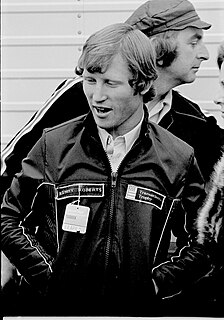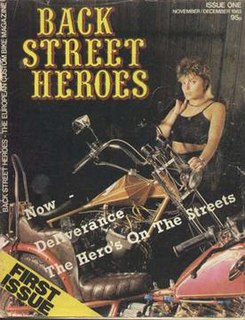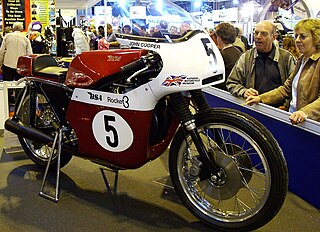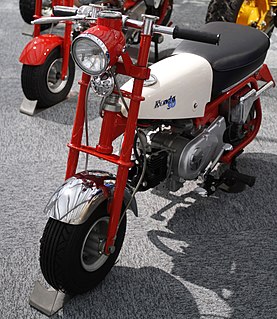
A motorcycle, often called a motorbike, bike, cycle, or trike, is a two- or three-wheeled motor vehicle. Motorcycle design varies greatly to suit a range of different purposes: long-distance travel, commuting, cruising, sport, and off-road riding. Motorcycling is riding a motorcycle and being involved in other related social activity such as joining a motorcycle club and attending motorcycle rallies.

Motocross is a form of off-road motorcycle racing held on enclosed off-road circuits. The sport evolved from motorcycle trials competitions held in the United Kingdom.

A custom motorcycle is a motorcycle with stylistic and/or structural changes to the 'standard' mass-produced machine offered by major manufacturers. Custom motorcycles might be unique, or built in limited quantities. While individual motorcyclists have altered the appearance of their machines since the very first days of motorcycling, the first individualized motorcycles specifically labeled 'Custom' appeared in the late 1950s, around the same time as the term was applied to custom cars.

The Suzuki GSX1300R Hayabusa is a sports motorcycle made by Suzuki since 1999. It immediately won acclaim as the world's fastest production motorcycle, with a top speed of 303 to 312 km/h.

David Mann was a California graphic artist whose paintings celebrated biker culture, and choppers. Called "the biker world's artist-in-residence," his images are ubiquitous in biker clubhouses and garages, on motorcycle gas tanks, tattoos, and on T-shirts and other memorabilia associated with biker culture. Choppers have been built based on the bikes first imagined in a David Mann painting.

A streetfighter or muscle bike is a motorcycle of high displacement and horsepower, typically a super bike, with the fairings and windscreen removed. Beyond simply removing fairings, specific changes that exemplify the streetfighter look are a pair of large, round headlights, tall, upright handlebars such as those on a motocross bike, and short, loud, lightweight mufflers, and changes in the sprockets to increase torque and acceleration at lower speeds. Streetfighters is also the name of a UK motorcycle magazine.

Kenneth Leroy Roberts is an American former professional motorcycle racer and racing team owner. In 1978, he became the first American to win a Grand Prix motorcycle racing world championship. He was also a two-time winner of the A.M.A. Grand National Championship. Roberts is one of only four riders in American Motorcyclist Association (AMA) racing history to win the AMA Grand Slam, representing Grand National wins at a mile, half-mile, short-track, TT Steeplechase and road race events.

A café racer is a genre of sport motorcycles that originated among British motorcycle enthusiasts of the early 1960s in London. Café racers were standard production bikes that were modified by their owners and optimized for speed and handling for quick rides over short distances. Café racers have since become popular around the world, and some manufacturers produce factory-made models that are available in the showrooms.

The six main types of motorcycles are generally recognized as standard, cruiser, touring, sports, off-road, and dual-purpose. Sport touring is sometimes recognized as a seventh category or integrated with the touring category.
State motorcyclists' rights organizations (SMROs) exist in about 32 US states, 25 of which call themselves "ABATE of ," the rest going by various other names. SMROs advocate for the motorcycle rider and freedom on the road. In the motorcycling world, that generally means they oppose mandatory helmet laws, restrictions on handlebar heights and the profiling of motorcycle riders. Instead ABATE encourages riders to safely ride their motorcycle how it is setup and actively promotes greater public awareness of motorcyclist and traffic safety issues. They also favor stronger penalties for car driver infractions such as right of way violations, or when drivers are at fault in accidents that harm motorcycle riders. SMRO activities include lobbying legislatures, letter writing campaigns, and paying for public service announcements and political advertisements. To carry out lobbying at the national level, a coalition of SMRO's, consisting primarily of state ABATE groups, created the Motorcycle Riders Foundation (MRF) to lobby in Washington DC. The SMROs and MRF are often allied with the American Motorcyclist Association (AMA) on legislative issues.

Motorcycling is the act of riding a motorcycle. For some people, motorcycling may be the only affordable form of individual motorized transportation, and small-displacement motorcycles are the most common motor vehicle in the most populous countries, including India, China and Indonesia.

Formula 750 was a FIM motorcycle road racing series based on a 750 cubic centimeter engine capacity.

Easyriders is an American motorcycle magazine, founded in 1970. It was published monthly by Paisano Publications for over 50 years.

The BSA Road Rocket was a 1950s 646 cc (39.4 cu in) air-cooled parallel twin motorcycle designed by Bert Hopwood and produced by Birmingham Small Arms Company (BSA) at Small Heath, Birmingham. Developed from the A10 Golden Flash it was the first sports bike in the BSA A10 series. The A10 had a reputation for reliability but was struggling to compete against the Triumph engines and the Norton Featherbed frames. Advertised by BSA in 1956 as 'undoubtedly the world's greatest motor cycle' the Road Rocket was discontinued in 1958 when it was replaced by the BSA Super Rocket.

Lou Kimzey (Sr.) (1928-1997) was the creator and publisher of the biker magazines Easyriders and Iron Horse.
Motorcycle Consumer News (MCN) was a monthly motorcycling magazine that reviewed motorcycles and accessories, and covered motorcycle safety, training and industry news. Unlike most publications, it was wholly subscriber-supported and did not accept advertising.

Back Street Heroes is a monthly UK custom bike magazine that helped to popularize a "new breed" of custom motorcycle, distinct from previous choppers because they combined rat bike-influenced utilitarian and minimalist design with greater use of high tech gadgetry, but catering to an upscale buyer in the Robb Report demographic.
Iron Horse, sometimes written Ironhorse, was a motorcycling magazine dedicated to biker culture, published between 1979 and 2011.

The Transatlantic Trophy was an annual series of motorcycle races between the United Kingdom and America held from 1971 to 1988 and again in 1991. They were mostly held over the Easter weekend at Brands Hatch, Mallory Park and Oulton Park, although some races were held at Donington Park and Snetterton. Three different specifications of motorcycles were used in the series at various times: AMA/F750, Superbike and GP.

Honda Z100 was a prototype Honda Motor Company minibike which was introduced at the Tama Tech amusement Park in Tokyo, Japan in 1961. The Z100 minibike was never meant to be produced and sold to consumers. The success of the Z100 prototype convinced Honda to produce and sell the minibike to consumers.




















